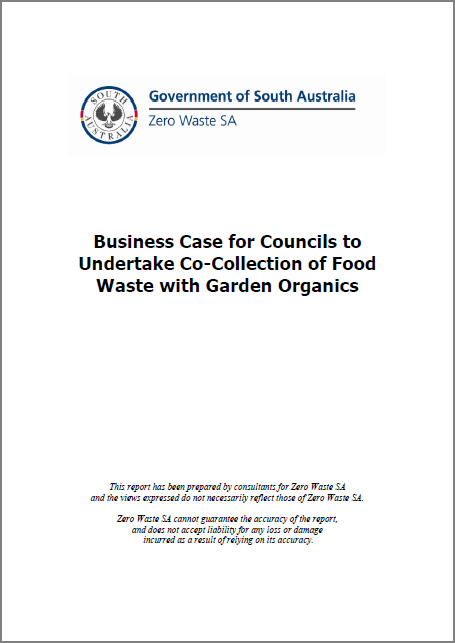
- Archive (pre-2016)
Business case for councils to undertake co-collection of food waste with garden organics (2007)
South Australia’s Waste Strategy 2005–2010 sets the following target for municipal solid waste: By 2010, 75% of all material presented at the kerbside is recycled (if food waste is included). Household waste and recyclables kerbside collection services vary between councils. The existing service that generates the highest diversion from landfill of collected materials uses 3 bins, a 120-140 litre mobile garbage bin (MGB) for waste – collected weekly, and a 240 litre MGB for recyclables and another for garden organics – both collected fortnightly. Zero Waste SA’s audits show such a service typically diverts 57% of all material from landfill. It is becoming councils’ preferred service and is now in place in just over half of all metropolitan municipalities. Burnside Council, with funding support from Zero Waste SA, successfully trialled a system that involved open windrow processing. This method offers considerable reduction in costs. The results of the Burnside trial were reviewed and all SA metropolitan and 3 regional councils surveyed in regard to their waste management services in research for this report. Council survey responses highlighted a strong interest in further improving landfill diversion rates but concerns about perceived cost implications. The typical variation in costs councils can expect to incur if they decide to introduce co-collection of food waste and garden organics were calculated based on information from the survey and other sources. If a council currently provides a fortnightly garden organics waste collection service then the additional cost to introduce food waste co-collection is of the order of $15 to $16 per household per annum. Where this service is provided in conjunction with a weekly 120-140 litre MGB residual waste collection and a fortnightly 240 litre MGB recyclables collection service it is likely to see landfill diversion rates increase to about 66% of all material presented at kerbside. By far the largest component of the cost of co-collection is the provision of corn starch (compostable) bags used for collecting food waste in the household kitchen. These are estimated to cost about $10 per household per annum. It is possible to introduce co-collection without provision of compostable bags but not recommended. Such a system is likely to have less householder acceptance and consequently participation and diversion rates are likely to be considerably less. It is also likely to lead to some householders using plastic bags to dispose of food waste and therefore lead to significant problems with contamination of collected and processed material. As demand develops it is likely that the market price of corn starch bags will fall in price in real terms (i.e. net of inflation) and/or cost-effective substitutes will emerge. If a council currently provides a 4 weekly garden organics collection service using a 240 litre MGB it would need to upgrade this service to fortnightly if it decided to co-collect food waste with garden organics for reasons of householder acceptance, public health and amenity. This would cost approximately a further $10 per household per annum on average.
Download




